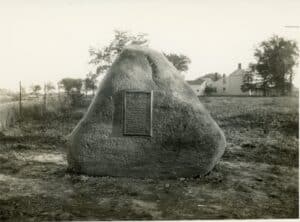John Johnston Groupies
Standing at the intersection of Route 96A and East Lake Road stands a 1,400-ton boulder from Taughannock Falls. Attached to the boulder is a plaque that states the following –
Johnston Memorial Dedication, October 9, 1935
Farm And Residence
Of
John Johnston
1791-1880
Eminent Farmer Who
Here Originated
Tile Underdrainage
In America in 1835
And Thereby Became An
Outstanding Contributor
To Human Welfare
Honored by
The American Society of
Agricultural Engineers
1935
Erected By
State Education Department
In life and in death John Johnston has had his groupies.
Born and raised in Scotland, John Johnston (1791–1880) came from generations of sheep farmers. In 1821, he traveled to the United States looking for the opportunity to build a profitable farm business. After reviewing land in Rochester, New York, and Illinois, he purchased 112 acres of land adjoining Rose Hill to the south. He named his farm Viewfields. Eventually, Viewfields would consist of 306 acres.
Though the land was worn out and previous owners failed to make it produce, Johnston still saw its potential. Using practical and innovative approaches to farming, Johnston began experimenting with his land. Many of Johnston’s techniques are commonplace today, but were considered radical in the mid-1800s. He used manure, left his fields fallow for portions of the year, and planted clover and used lime to enrich the soil.
 After years of his farm not producing what it should, Johnston concluded that he had wet soil. He believed he could increase his crop yields if he could drain his land. At first Johnston only tiled ten acres of land and saw his wheat yields increase from five bushels of wheat per acres to fifty bushels per acre. He was the first farmer in the United States to use drain tile to improve the productivity of his land.
After years of his farm not producing what it should, Johnston concluded that he had wet soil. He believed he could increase his crop yields if he could drain his land. At first Johnston only tiled ten acres of land and saw his wheat yields increase from five bushels of wheat per acres to fifty bushels per acre. He was the first farmer in the United States to use drain tile to improve the productivity of his land.
Johnston’s neighbors made fun of him for “burying crockery in the ground,” but his increasing crop yields soon persuaded other farmers to follow his example. Eventually, Johnston had over fifty miles of drain tile on his farm. Johnston advocated for the use of drain tiles and other improved farming methods by writing letters to agricultural journals like the Genesee Farmer, Cultivator, and County Gentleman. These letters were reprinted in agricultural journals and newspapers throughout the United States and Canada. He also received and answered letters and welcomed visitors to his farm. By the early 1860s, Johnston was known of as the “Father of Tile Drainage in the United States.”
To mark the 100th anniversary of Johnston installing the first drain tile system in the United States the memorial boulder on the land formerly owned by Johnston. Led by the American Society of Agricultural Engineers , the memorial’s installation was a group effort. The New York State Department of Education gave the bronze plaque. The land was donated by Hobart College, who owned the property at the time. The New York State Agricultural Experiment Station agreed to care for the boulder and the area surrounding it with funding from Johnston’s granddaughter Agnes Swan Hutchins. Dr. L. H. Bailey, Emeritus Professor of Agriculture at Cornell, provided the verbiage for the plaque.

Agnes Swan Hutchins with some of the speakers for the Johnston Memorial Dedication, October 9, 1935
On October 9, 1935 over 200 people gathered at the former Johnston Farm for the dedication. Speakers were Dr. U.P. Hedrick, Director of the Experiment Station; L.F. Livingston, President of the American Society of Agricultural Engineers; Dr. A.C. Flick, New York State Historian; S.H. McCrory, Bureau of Agricultural Engineering at the United States Department of Agriculture; and Dr. L.H. Bailey.
After remarks a tour of where the first drain tile had been laid was given followed by a tea and reception at the home of Agnes Swan Hutchins. During the reception Hutchins shared a few remarks about her grandfather.
Nearly 100 years later groupies continue to make their way to the Johnston House and Mike Weaver Drain Tile Museum. There was the couple from Canada and the wife’s father had been the drain king of northern Ontario. A Minnesota farmer had Johnston House on his list of place to visit and had his teenaged children pose in front of the drain tile museum for their annual Christmas card. In June 2015 after Rochester Magazine featured an article about Johnston there was a 125% increase in visitation to Johnston House.
As an aside, in August December 1964 the Geneva Daily Times reported the disappearance of the plaque from the memorial boulder. Apparently someone (with or without a little help) had actually unfastened and removed it. Eight months later a janitor found the plaque in a dorm room at Keuka College. Through the efforts of the Historical Society the plaque was returned and reattached to the boulder.
2021 marks the 200th anniversary of Johnston settling in the area. The Historical Society is commemorating the anniversary with an exhibit on Geneva innovators, blog articles, and social media posts.

